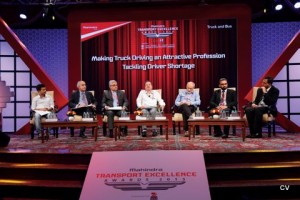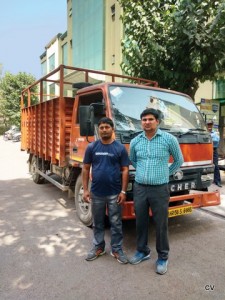Commercial vehicle drivers are a valuable lot; they are scarce and crucial to the smooth operation of fleets.
Story by:
Anirudh Raheja
A panel discussion leading up to the fifth edition of the Mahindra Transport Excellence Awards at Delhi put the spotlight on commercial vehicle drivers. Panelists comprised of NGO representatives, academia, CV industry and government bodies. The event was supported by the Ministry of Road Transport and Highways (MoRTH) and recognised the good work put up by transporters, logistics companies, truck fleet owners, commercial vehicle financiers, dealers and other stakeholders of the road transport ecosystem in India. Scrutiny was based on stringent parameters. Unlike the earlier editions, the fifth edition comprised of some innovative categories of awards including special focus on haulage fleet operators, drivers (based on their knowledge), tipper segment and emerging transport businesses.
Delivering life-saving oxygen cylinders to hospitals on time, truck driver Ramcharan Yadav, won the ‘Super Outperformer Driver of the Year’ award. He was presented with a new Mahindra Blazo 25 truck. Encouragement like this will work wonders. It has given Yadav the opportunity to turn into an entrepreneur. The plight of others is however not hidden. A report by research firm Crisil has highlighted that the number of skilled truck drivers has gone down from 778 per thousand trucks in FY2010 to 682 in FY2016. The number of truck drivers is expected to dip to 480 by FY2022. Progressing towards higher tonnage vehicles that are modern, the trucking industry is coming to realise that the truck driver is an important asset to the fleet business. Chairing the panel, Abhay Damle, Joint Secretary, MoRTH, drew attention to the harassment meted out to the driver while issuing of the licence at the road transport offices, which may often involve a wait of up to one year time for issuance of licence. “It is due to such delays the drivers often migrate towards other jobs. And even if they initiate, sustainability of drivers has gradually become a serious issue that needs quick look,” he mentioned.
Important to upgrade driver skills
Representing academia, Prof. G Raghuram, Dean of Faculty, IIM Ahmedabad, underlined the fact that driver should have a sound understanding of the vehicle he will drive, the nature of goods he will ferry, and if the load is within the permissible limit. “It is factors like these that snowball into driver harassment. It is the driver who has to face the wrath of the authorities during the transit of goods. Driver quantities are already dwindling with low salaries prevailing in the sector and stress related to prolonged driving without rest,” expressed Raghuram. He stated that there was a need to properly channelise the money invested on road development by the government and regulators. The two should play a pivotal role in minimising the harassment, said Raghuram. Pointing at the manufacturers, Raghuram averred that they are doing their job by developing better vehicles, it is the government that needs to re-look into road engineering quickly as both the factors together have significant consequences.
Important factors like upgradation of skills of the drivers and reducing the stress were also discussed. It is estimated that over the next three years, said a panelist, there will be a rise of 54 per cent in freight. Most of this would be by road, and the current shortage of drivers stands close to eight lakh in M&HCV segment, he exclaimed. He stated that the overall increase in freight transport by road will amount to 63 per cent of the total freight in the country, accounting to a CAGR growth of 13.5 per cent till 2020, led primarily by the manufacturing sector, FMCG, eCommerce and retail. Rajan Wadhera, President – Truck and Power Train Division and Head – Mahindra Research Valley and Member – Group Executive Board, expressed that they have been increasing the pace of development of new vehicles by upgrading from 25-tonne to 31-tonne, and from 31-tonne to 37-tonne trucks. Stressing on the need to upgrade driver skills as trucks with higher carrying capacity are made available, Wadhera said, “such trucks will significantly reduce the requirement of another driver.” He opined that drivers need to evolve faster to harness the real benefits of technology. Claiming that the idling time for commercial vehicles is higher, Wadhera quipped that the training of drivers and upgradation of their skill set through recognised institutes should be combined with improved infrastructure to increase the distance travelled per day.
Curbing external factors
Out of the six million labour force in the country, only 2.5 per cent make truck drivers. Citing a report, a panelist claimed that a whopping Rs.24,000 crores was paid by truck drivers as bribe in 2013. The practice of giving a bribe continues to grow at an enormous rate, he added. Panelist Patanjali Nayar, Regional Advisor to the World Health Organisation said, none of the truck drivers want their next generation to follow in their footsteps due to the harassment they are meted out. Rising harrasment levels are a growing concern for the industry. High level of discomfort related to health, mental, physical and sexual health are playing a vital role in stopping people from taking truck driving as a profession, explained Nayar. Stressing the fact that road fatalities are among the highest in India, and truck drivers who are persistently on road, are either victims or turn out to be spectators, Nayar called the installation of social security measures. “While on the job if someone from the driver’s family falls sick, the law does not support the kind of requirement a person in an office gets. Driver fraternity is an highly unorganised sector, and the risks are high, said Gaurav Agarwal, amicus curiae appointed by the Supreme Court of India. Agarwal called for support from various aggregators like insurance companies and NGOs to come forward and make the life of drivers safe.
Possible solutions
The Supreme Court of India recently passed a rule to protect good Samaritans that help road accident victims. Piyush Tiwari, CEO of Savelife Foundation said that it would amount to contempt of court if the states do not comply with the law, which actually makes such guidelines reliable. Asking for support from the aggregators, Tiwari mentioned, “Fleet management polices should be solicited. It should be clearly understood at all levels in the company how drivers should be dealt with and what polices have been drafted to safeguard their interests. The interest of the drivers should be clearly understood.” The panel unanimously arrived at a conclusion that there should be a central database for the drivers to simplify their lives irrespective of their changing the job. Even though the road transport authorities are state dependent, the central government should push for the necessary and overdue reformation of RTOs. Equally important is to increase their social standards and encourage them to become entrepreneurs. Not all of them can be the heroes of the highways.























